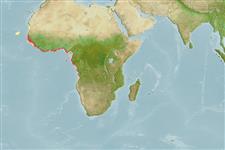Issue
Distribution will be corrected.
Environment: milieu / climate zone / depth range / distribution range
Ecologia
marinhas; estuarina demersal; intervalo de profundidade 1 - 60 m (Ref. 4438). Tropical; 21°N - 17°S
Eastern Central Atlantic: Senegal to Congo (Ref. 114953).
Tamanho / Peso / Idade
Maturity: Lm ? range ? - ? cm
Max length : 100.0 cm WD macho/indeterminado; (Ref. 3170); common length : 60.0 cm WD macho/indeterminado; (Ref. 26999); peso máx. publicado: 20.0 kg (Ref. 81259)
Vértebras: 130. Diagnosis: A large Dasyatis species most closely related to the much smaller Dasyatis margaritella and to the extremely flat D. garouaensis (Ref. 26277). Pearl spines always present and very large; denticles on dorsal surface of disc smooth, restricted to middle portion (Ref. 26277).
Dasyatis margarita is a coastal marine species, entering lagoons, shallow bays and estuaries (Ref. 3497, 81259). Feeds on shrimps, crabs, bivalves and annelids (Ref. 28587). Ovoviviparous (Ref. 50449).
Ciclo de vida ou comportamento de acasalamento
Maturities | Reprodução | Spawnings | Egg(s) | Fecundities | Larvas
Exhibit ovoviparity (aplacental viviparity), with embryos feeding initially on yolk, then receiving additional nourishment from the mother by indirect absorption of uterine fluid enriched with mucus, fat or protein through specialised structures (Ref. 50449). Distinct pairing with embrace (Ref. 205).
Capapé, C. and M. Desoutter, 1990. Dasyatidae. p. 59-63. In J.C. Quero, J.C. Hureau, C. Karrer, A. Post and L. Saldanha (eds.) Check-list of the fishes of the eastern tropical Atlantic (CLOFETA). JNICT, Lisbon; SEI, Paris; and UNESCO, Paris. Vol. 1. (Ref. 4438)
Status na Lista Vermelha da UICN (Ref. 130435)
Ameaça para os humanos
Harmless
Uso pelos humanos
Pescarias: espécies comerciais
Ferramentas
Relatórios especiais
Baixar XML
Fontes da internet
Estimates based on models
Preferred temperature (Ref.
123201): 23 - 28, mean 26.5 °C (based on 76 cells).
Índice de diversidade filogenética (Ref.
82804): PD
50 = 0.5156 [Uniqueness, from 0.5 = low to 2.0 = high].
Bayesian length-weight: a=0.00832 (0.00366 - 0.01891), b=3.10 (2.90 - 3.30), in cm total length, based on LWR estimates for this (Sub)family-body shape (Ref.
93245).
Nível Trófico (Ref.
69278): 3.4 ±0.50 se; based on food items.
Resiliência (Ref.
120179): Baixo, tempo mínimo de duplicação da população 4,5 - 14 anos (Assuming fecundity<100).
Fishing Vulnerability (Ref.
59153): Very high vulnerability (90 of 100).
Nutrients (Ref.
124155): Calcium = 34.7 [8.3, 159.9] mg/100g; Iron = 0.765 [0.192, 2.007] mg/100g; Protein = 21.9 [19.0, 24.9] %; Omega3 = 0.174 [0.049, 0.512] g/100g; Selenium = 41.1 [11.0, 113.3] μg/100g; VitaminA = 13.3 [5.9, 29.3] μg/100g; Zinc = 1.1 [0.5, 2.0] mg/100g (wet weight);
